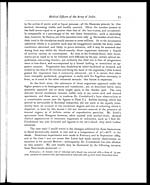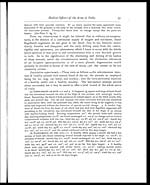Medicine - Institutions > Army health reports and medical documents > Scientific memoirs by medical officers of the Army of India > Part III, 1887 > 7 - On the lately demonstrated blood-contamination and infective disease of the rat and equines in India
(60) Page 54
Download files
Individual page:
Thumbnail gallery: Grid view | List view

54
Scientific Memoirs by
After 3 hours, in the lateral open spaces movement less active, the thick end of the filaments
seems to drag and bulge at intervals, showing a contractility of its substance which is still
uniformly clear: blood-cells unchanged, the red forming rouleaux; some micrococci have
appeared oscillating apart. As the monads become quiscent they seem more slender and
flattened, the ribbon-like margin wavy or angular; and that this change is not due to
simple dessication is evident from the red discs preserving their form and floating freely:
next, a stiff crumpled aspect ensues, the body of the organism assuming a skate-like form,
the flagellum being still round, flexible, and mobile. At 4½ hours a few bright dots appear
in the motionless body, the flagellum still occasionally lashing spasmodically as it were
and now it would be hard to recognise the monad. At 5 hours, the bright dots are distinct
but not more numerous, the flagellum bent, clear and quiet: red discs unaltered. Another
specimen shows that the bright specks might be due mainly to knots or foldings, but some
resemble 'vacuoles.' Not every one of the organisms here presents identical changes at
the same hour, nor are all the red discs precisely alike; therefore some difference of indi-
vidual properties may be inferred. The above description applies to the parts towards the
edge of the thin glass cover, whilst nearer the centre of the preparation where the blood-
clot rests the changes are very much less marked and the organisms are still active; in the
central part, appearances remain precisely as at beginning of the experiment. Shortly
afterwards, the changed monads at the sides were but faintly visible; and on the following
day (27 hours) no other changes indicative of development were to be seen in the
specimens, which had then become clouded. In an experiment with blood diluted with
aqueous humour of the rat, the monads had in the course of 4 hours become shrunken,
bent, stiff, granular, and motionless: whilst in similar blood diluted with the salt-solution,
they remained very active at a like interval.
September. —Further trials made, and as a sample the following is quoted:—After 22
hours the organisms in the centre of the preparation grouped in open spaces mostly quies-
cent; the thicker end is pointed and the body shows a clear space between two bright
spots; towards the margin they were more shrivelled, granular, and dotted in their
whole length, excepting the flagellum itself. Red blood-discs somewhat mis-shapen,
leucocytes, quiescent, and filled with granules; a few free cocci present, no bacilli. A
moving monad in the centre being watched, it advanced like a worm, the attenuated end
in front, and the hinder thicker end being drawn up towards the front end fixed as a kind
of fulcrum: the first stage in this process is the projection of the flagellum; and the next
the dragging forward of the thicker part by successive wriggling movements not wholly
sluggish: the body or thick part is distinctly granular, and contains bright particles of
different dimensions and seemingly imbedded in its substance. Occasionally a brief retro-
grade movement is noticed. Later (24 hours), the body sometimes is flattened, angular,
dotted, and quiescent, the flagellum still being jerked at brief intervals; it seems as if the
body becomes too heavy, or is the first to fail; one or two of the bright granules are
largest and connected with the angular projections. Micrococci free are present, and
others apparently growing within the leucocytes. At 46 hours the monads not much
altered in the centre of the preparation; the broader part is quiescent, expanded, angular,
and of granular aspect; the narrow end is distinct and languidly moves at intervals. The
blood-elements are hardly altered: active micrococci are seen in some places. At 76 hours
all is faint yet clear, the blood-cells not greatly changed; the monads are still visible,
though shrunken, granular and bent, with no signs of growth. At 117 hours the organ-
isms visible, with granules in their thicker part, but no signs of spore-production, the
attenuated end is clear and possibly a little swollen: red blood-discs faint, leucocytes
Set display mode to: Large image | Zoom image | Transcription
Images and transcriptions on this page, including medium image downloads, may be used under the Creative Commons Attribution 4.0 International Licence unless otherwise stated. ![]()
| Permanent URL | https://digital.nls.uk/75004186 |
|---|
| Shelfmark | IP/QB.10 |
|---|---|
| Additional NLS resources: | |




